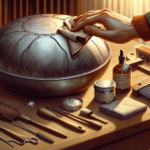<!DOCTYPE html>
<html lang="en">
<head>
<meta charset="UTF-8">
<meta name="viewport" content="width=device-width, initial-scale=1.0">
<title>Craftsmanship Meets Culture: Handpan Makers at the Swiss Festival</title>
<style>
body {
font-family: Arial, sans-serif;
line-height: 1.6;
margin: 0;
padding: 20px;
background-color: #f4f4f4;
}
h2 {
color: #333;
}
p {
margin-bottom: 20px;
}
ul {
list-style-type: disc;
margin: 10px 0;
padding-left: 40px;
}
</style>
</head>
<body>
<h2>Introduction</h2>
<p>In the heart of Switzerland, an artistic confluence takes place every year where music melds seamlessly with meticulous craftsmanship. The Swiss Festival, known for its vibrant celebration of cultures and traditions, becomes a sanctuary for artisans and musicians alike who exhibit their unique creations. One standout aspect of this festival is the gathering of handpan makers and performers who showcase not just an instrument but a soulful blend of rhythm, craftsmanship, and cultural heritage.</p>
<h2>The Handpan: An Instrument of Enchantment</h2>
<p>The handpan is a relatively modern musical instrument, captivating audiences with its celestial sound and unique design. Its creation can be traced back to the year 2000, when musicians Felix Rohner and Sabina Schärer of PANArt Hangbau AG in Switzerland invented the predecessor of the modern handpan. The instrument's resonant sound, resembling harmonics of a drum combined with melodic qualities, has made it a favorite among musicians and listeners seeking a therapeutic auditory experience.</p>
<h2>Craftsmanship at its Finest</h2>
<p>The artistry involved in handpan making is a remarkable blend of skill, precision, and passion. Artists from around the world journey to the Swiss Festival to display their unique creations, each handpan echoing the distinctive touch of its maker. Switzerland, with its legacy of precision in craftsmanship—be it in watchmaking or music instrument creation—provides the perfect backdrop for this cultural tapestry to unfold.</p>
<p>Creating a handpan is no small feat. The process begins with choosing the right metal, usually nitrided steel, known for its enduring, resonant quality. The metal is then carefully shaped, hammered, and tuned, sometimes taking up to several weeks to perfect a single instrument. Each hammered section of a handpan can produce a different note, and the layout of these sections can vary greatly, depending on the desired scale and sound complexities.</p>
<h2>Handpan Makers at the Swiss Festival</h2>
<p>At the Swiss Festival, handpan makers are provided a platform to not only sell their instruments but also to engage directly with the audience, musicians, and enthusiasts. This interaction allows artisans to gain insight into how their creations are played and perceived. Festival goers have the unique opportunity to witness live demonstrations, engage in workshops, and even try their hands at creating simple versions of handpans.</p>
<p>Prominent names in the handpan world often grace the festival, such as <em>Saraz Handpans</em>, <em>Leaf Handpans</em>, and <em>Ayasa Instruments</em>. Each maker brings a unique philosophy and approach to their creations, contributing to a rich tapestry of soundscapes and making the festival a vibrant and dynamic event for both participants and attendees.</p>
<h2>Cultural Significance and Community Building</h2>
<p>The Swiss Festival is more than just a musical showcase; it is a meeting point for cultural exchange and community building. Handpan makers and musicians from diverse backgrounds converge, fostering an inclusive environment where traditional boundaries blur and artistry thrives. The festival becomes a space where stories are shared, collaborations are born, and friendships are forged, transcending linguistic and cultural barriers.</p>
<p>Workshops and discussion groups enable attendees to delve deeper into the cultural significance of music and craftsmanship. These sessions explore the intersection of music with mindfulness, meditation, and wellness, often branching into exploratory conversations about music therapy and the handpan's role in it. This discourse echoes the universal language of music, promoting a message of unity and interconnectedness.</p>
<h2>A Global Community of Handpan Lovers</h2>
<p>The handpan community is a global phenomenon, and events like the Swiss Festival are pivotal in strengthening these connections. Enthusiasts from different continents come together, sharing techniques, styles, and ideas, creating an evolving narrative that keeps the art of handpan making and playing alive and vibrant. Social media and online forums further contribute to this narrative, allowing the community to remain connected beyond the festival itself.</p>
<h2>Conclusion</h2>
<p>The Swiss Festival is a remarkable celebration of art, culture, and craftsmanship, epitomized by the presence of handpan makers who share their passion and dedication with the world. This event is more than an exhibition; it is a living dialogue between cultures, where music becomes a universal language bridging distances and differences. As handpan makers continue to innovate and inspire, they contribute not only to the preservation of this unique art form but also to its evolution, ensuring that the enchanting sound of the handpan continues to resonate across cultures and generations.</p>
<h2>FAQs</h2>
<ul>
<li>
<strong>What is a handpan?</strong>
<p>The handpan is a musical instrument known for its unique, melodic sound. It is a modern percussion instrument derived from the steel pan and consists of a central dome with surrounding hammered areas that produce different notes.</p>
</li>
<li>
<strong>How is a handpan made?</strong>
<p>Handpans are crafted from carefully selected metal, typically nitrided steel, which is shaped, hammered, and tuned to create specific musical notes. The process is labor-intensive and requires significant skill and precision.</p>
</li>
<li>
<strong>Why is the Swiss Festival significant for handpan makers?</strong>
<p>The Swiss Festival provides a platform for handpan makers to showcase their work, engage with musicians and enthusiasts, and participate in cultural exchanges. It is an important event for community building and promoting the art of handpan making.</p>
</li>
<li>
<strong>Can I learn to play the handpan at the Swiss Festival?</strong>
<p>Yes, the festival often features workshops and sessions where attendees can learn about handpan playing techniques, engage in hands-on activities, and receive guidance from experienced players and makers.</p>
</li>
<li>
<strong>How does the handpan contribute to cultural and community efforts?</strong>
<p>The handpan, through its unique sound and the community it creates, serves as a tool for cultural transmission, fostering inclusivity, collaboration, and a deeper connection among diverse cultural groups at events like the Swiss Festival.</p>
</li>
</ul>
</body>
</html>Craftsmanship Meets Culture: Handpan Makers at the Swiss Festival

Leave a comment




